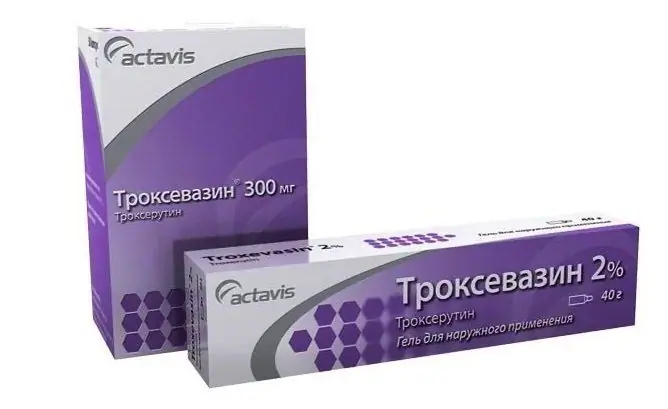- Author Rachel Wainwright [email protected].
- Public 2023-12-15 07:39.
- Last modified 2025-11-02 20:14.
Ginipral
Ginipral: instructions for use and reviews
- 1. Release form and composition
- 2. Pharmacological properties
- 3. Indications for use
- 4. Contraindications
- 5. Method of application and dosage
- 6. Side effects
- 7. Overdose
- 8. Special instructions
- 9. Application during pregnancy and lactation
- 10. In case of impaired renal function
- 11. For violations of liver function
- 12. Drug interactions
- 13. Analogs
- 14. Terms and conditions of storage
- 15. Terms of dispensing from pharmacies
- 16. Reviews
- 17. Price in pharmacies
Latin name: Gynipral
ATX code: R03CC05
Active ingredient: hexoprenaline (hexoprenaline)
Manufacturer: MbH GLOBOPHARM Pharmazeutische Produktions- und Handelsgesellschaft (Austria), Takeda (Germany), GmbH Nycomed Austria (Austria)
Description and photo update: 2019-16-08
Prices in pharmacies: from 199 rubles.
Buy

Ginipral is a drug that helps to reduce the tone and contractile activity of the myometrium.
Release form and composition
Ginipral is available in the following dosage forms:
- Tablets: white, biconvex, round (10 pcs. In blisters, 2 blisters in a cardboard box);
- Solution for intravenous administration: colorless, transparent (in 2 ml ampoules, 5 ampoules in plastic trays, 1 or 5 trays in a cardboard box).
The composition of 1 tablet includes:
- Active ingredient: hexoprenaline sulfate - 0.5 mg;
- Auxiliary components: talc, corn starch, copovidone, lactose hydrate, disodium edetate dihydrate, magnesium stearate, glycerol palmitate stearate.
The composition of 1 ml includes:
- Active substance: hexoprenaline sulfate - 0.005 mg;
- Auxiliary components: disodium edetate dihydrate, sulfuric acid 2N (to maintain the pH level), sodium pyrosulfite, sodium chloride, water for injection.
Pharmacological properties
Pharmacodynamics
The action of the drug is based on the mechanisms of selective stimulation of β 2 -adrenergic receptors and activation of adenylate cyclase, followed by an increase in the production of cyclic adenosine monophosphate, which stimulates the work of the calcium pump, which redistributes calcium ions (Ca 2+) in myocytes and reduces its concentration in myofibrils. Expands blood vessels, bronchi, reduces the tone and contractile activity of the myometrium, as a result of which the uteroplacental blood flow improves. Stimulates glycogenolysis.
Due to β 2 -selectivity, Ginipral insignificantly affects the blood flow and cardiac activity of the pregnant woman and the fetus. When it is taken, the tone decreases, the intensity and frequency of uterine contractions, including their complete cessation, decreases, which makes it possible to prolong the pregnancy until the onset of timely delivery.
When administered intravenously, hexoprenaline inhibits oxytocin-induced and spontaneous labor pains, and normalizes irregular and excessively strong contractions during childbirth.
When administered intravenously, the tocolytic effect of the drug begins immediately after injection and lasts about 20 minutes. The effect of the drug is maintained by subsequent long-term intravenous infusion.
Pharmacokinetics
- absorption: after oral administration, from 5 to 11% of hexoprenaline is absorbed from the gastrointestinal tract. The time to reach maximum concentration is approximately 2 hours;
- distribution: there are no data on the distribution of the active substance in the human body. When conducting studies on animals in the case of intravenous administration, significant concentrations of hexoprenaline were found in skeletal muscles, kidneys, liver, and to a lesser extent in the myocardium and brain;
- metabolism: hexoprenaline is metabolized by catechol-O-methyltransferase to mono-3-O-methyl-hexoprenaline and to di-3-O-methyl-hexoprenaline;
- Elimination: when taken orally, the elimination half-life is about 50 minutes. Up to 90% of the drug is excreted through the intestines, up to 5% - by the kidneys in the form of glucuronides. When administered intravenously, the elimination half-life is about 25 minutes. Within 1 day, about 44% of the hexoprenaline dose is excreted by the kidneys, and about 5% through the intestines. Over the next 8 days, these figures are 54% and 15.5%, respectively. At the initial stage, both free hexoprenaline and methylated metabolites, sulfates and conjugates of both metabolites with glucuronic acid are excreted by the kidneys. In urine after 2 days, only di-3-O-methyl-hexoprenaline is found. Approximately 10% of the dose is excreted in the bile, mainly conjugates of O-methylated metabolites. Some reabsorption occurs in the intestines, since less substance is excreted with feces,rather than found in bile.
Indications for use
According to the instructions, Ginipral in the form of a solution for injection is prescribed in the following cases:
- Massive tocolysis: to inhibit premature labor pains when the pharynx opens and / or the presence of a flattened cervix;
- Acute tocolysis: as an emergency measure in preterm labor before the delivery of the pregnant woman to the hospital; for inhibition of labor pains during childbirth with immobilization of the uterus before cesarean section, acute intrauterine asphyxia, complicated labor, umbilical cord prolapse, as well as before turning the fetus from a transverse position;
- Prolonged tocolysis: for the prevention of premature birth with frequent or increased contractions without opening the pharynx or smoothing the cervix; when immobilizing the uterus before, during and after cervical cerclage.
Ginipral in the form of tablets is used with the threat of premature birth (most often as a continuation of infusion therapy).
Contraindications
- Tachyarrhythmias;
- Thyrotoxicosis;
- Aortic stenosis and mitral valve disease;
- Myocarditis;
- Severe kidney and liver diseases;
- Arterial hypertension;
- Cardiac ischemia;
- Premature placental abruption, uterine bleeding;
- Intrauterine infections;
- Closed-angle glaucoma;
- Lactation period (breastfeeding);
- Hypersensitivity to the components of the drug (especially in patients with bronchial asthma and a history of hypersensitivity to sulfites).
During pregnancy, Ginipral is contraindicated in the first trimester.
Instructions for use of Ginipral: method and dosage
The solution is injected intravenously slowly over 5-10 minutes. The doctor selects the dose individually. The Giniprala dropper is placed after dilution to 10 ml with isotonic sodium chloride solution, using automatic dosing infusomats or conventional infusion systems.
The scheme for using Ginipral's droppers is determined by the indications:
- Massive tocolysis: the introduction of Ginipral begins with 0.01 mg (1 ampoule of 2 ml) followed by an infusion at a rate of 0.0003 mg per minute. It is also possible to administer the drug by infusion without prior bolus administration;
- Acute tocolysis: the drug is used at a dose of 0.01 mg. If necessary, further therapy can be continued with infusions;
- Long-term tocolysis: Ginipral is prescribed as a long-term drip infusion at a rate of 0.000075 mg per minute.
If the contractions do not resume within 48 hours, treatment is continued with Ginipral tablets.
Ginipral tablets are taken orally with a small amount of water.
With the threat of premature birth, Ginipral is prescribed in a dose of 0.5 mg (1 tablet) 1-2 hours before the end of the infusion.
First, take 1 tablet every 3 hours, then every 4-6 hours. The daily dose is from 4 to 8 tablets (2-4 mg).
Side effects
- Central and peripheral nervous system: dizziness, headache, slight tremor of the fingers, anxiety;
- Digestive system: rarely - vomiting, nausea, suppression of intestinal motility, a temporary increase in the level of transaminases, intestinal obstruction (it is recommended to control the regularity of the stool);
- Cardiovascular system: maternal tachycardia (in most cases, the fetal heart rate remains unchanged), arterial hypotension (often diastolic); rarely - cardialgia (usually, after discontinuation of the drug, they quickly disappear), rhythm disturbances (ventricular extrasystole);
- Laboratory indicators: hypocalcemia at the beginning of treatment, hypokalemia, increased plasma glucose levels;
- Allergic reactions: bronchospasm, difficulty breathing, impaired consciousness up to coma, anaphylactic shock (in patients with bronchial asthma or hypersensitivity to sulfites);
- Others: oliguria, increased sweating, edema (especially in patients with kidney disease).
In newborns, side effects can manifest as acidosis and hypoglycemia.
Overdose
Symptoms: anxiety, tremors, increased sweating, dizziness, headaches, arrhythmia, tachycardia, cardialgia, shortness of breath, lowering blood pressure.
Therapy: symptomatic treatment. Non-selective beta-blockers are prescribed as antidotes, which completely neutralize the effect of Ginipral. In this case, the risk of developing bronchospasm should be taken into account when treating patients suffering from bronchial asthma.
special instructions
When using Ginipral, it is recommended to carefully monitor the function of the cardiovascular system (blood pressure, heart rate) of the fetus and mother. An ECG should also be recorded before and during treatment.
Patients with hypersensitivity to sympathomimetics are advised to prescribe small doses of Ginipral, which the doctor selects individually. Also, such patients need constant medical supervision.
With a significant increase in the mother's heart rate (more than 130 beats per minute) or / and with a pronounced decrease in blood pressure, the dose of the drug should be reduced.
If signs of heart failure, pain in the heart and shortness of breath occur, the use of Ginipral should be stopped immediately.
During therapy, especially in the initial period, an increase in blood plasma glucose is possible, and therefore in mothers with diabetes mellitus, it is necessary to monitor the parameters of carbohydrate metabolism. If childbirth occurs immediately after the course of treatment, the possibility of developing acidosis and hypoglycemia in the newborn, which is associated with transplacental penetration of ketone and lactic acids, should be considered.
When using Ginipral, diuresis decreases, so you need to carefully monitor for signs of fluid retention in the body.
Sometimes the simultaneous use of glucocorticosteroids during Ginipral's infusions can lead to pulmonary edema. Therefore, during infusion therapy, constant monitoring of the patient's condition is necessary. This is especially important when combined treatment with glucocorticosteroids in patients with kidney disease. Excessive fluid intake must be strictly limited. Due to the risk of possible development of pulmonary edema, the volume of infusions should be limited as much as possible. It is also recommended to limit the amount of salt in the diet.
During the period of use of the drug, you need to monitor the regularity of the intestines.
Before starting tocolytic treatment, you need to take potassium preparations, since the effect of sympathomimetics on the myocardium with hypokalemia increases.
The simultaneous use of sympathomimetics and general anesthetics (halothane) can cause cardiac arrhythmias. Therefore, before using halothane, Ginipral therapy should be discontinued.
With prolonged tocolytic therapy, it is necessary to monitor the state of the fetoplacental complex. It is also necessary to make sure that there is no placental abruption, the clinical symptoms of which can be mitigated against the background of tocolytic therapy. When the cervix is dilated by more than 2-3 cm and rupture of the membranes, the use of Ginipral is ineffective.
When carrying out tocolytic treatment with beta-adrenergic agonists, the symptoms of concomitant dystrophic myotonia may increase. In these cases, the use of diphenylhydantoin (phenytoin) preparations is recommended.
It is possible that the side effects of Ginipral may increase when used in the form of tablets with coffee or tea.
Application during pregnancy and lactation
Ginipral during pregnancy is contraindicated to use until the 20th week of pregnancy. From the 20th week of pregnancy, it is allowed to use the drug according to indications.
When breastfeeding, Ginipral is contraindicated.
With impaired renal function
In severe kidney disease, the use of Ginipral is contraindicated.
For violations of liver function
In severe liver diseases, the use of Ginipral is contraindicated.
Drug interactions
With the simultaneous use of Ginipral with some drugs, undesirable effects may occur:
- Beta-blockers: weakening or neutralization of the action of Ginipral;
- Oral hypoglycemic drugs: weakening their action;
- Methylxanthines (including theophylline): increasing the effectiveness of Ginipral;
- Glucocorticosteroids: a decrease in the intensity of accumulation of glycogen in the liver;
- Other drugs with sympathomimetic activity (bronchodilator and cardiovascular drugs): the appearance of symptoms of an overdose and an increase in the effect of these drugs on the cardiovascular system;
- Fluorotane and beta-adrenostimulants: increased side effects of Ginipral on the part of the cardiovascular system.
Ginipral is incompatible with tricyclic antidepressants, monoamine oxidase (MAO) inhibitors, ergot alkaloids, as well as with medicines containing vitamin D and calcium, mineralocorticoids and dihydrotachysterol.
Sulfite is a highly active component, therefore, Ginipral should not be mixed with any other solutions, except for 5% glucose (dextrose) solution and isotonic sodium chloride solution.
Analogs
Ginipral's analogues are: Ipradol, Metacin, Nifedipine, Magne B6, Hexoprenaline, Parusisten, Yutopar.
Terms and conditions of storage
Store at a temperature of 18-25 ° C, protected from light, out of reach of children.
Shelf life:
- Solution for intravenous administration - 3 years;
- Tablets - 5 years.
Terms of dispensing from pharmacies
Dispensed by prescription.
Reviews about Ginipral
Reviews about Ginipral are mostly positive: if the dosage is observed, it has the declared effect and allows you to prevent premature birth. As a rule, the drug is well tolerated, the most common side effects are dizziness quickly disappearing after taking the pill and nausea.
It must be remembered that you can take Ginipral only as directed by your doctor.
Price for Ginipral in pharmacies
The approximate price for Ginipral is 270 rubles. for 5 ampoules of 2 ml.
Ginipral: prices in online pharmacies
|
Drug name Price Pharmacy |
|
Ginipral 10 μg / 2 ml solution for intravenous administration 2 ml 5 pcs. 199 RUB Buy |
|
Ginipral solution for intravenous injection 5mkg / ml 2ml 5 pcs. 261 r Buy |

Maria Kulkes Medical journalist About the author
Education: First Moscow State Medical University named after I. M. Sechenov, specialty "General Medicine".
Information about the drug is generalized, provided for informational purposes only and does not replace the official instructions. Self-medication is hazardous to health!






